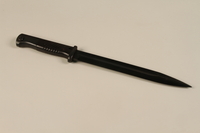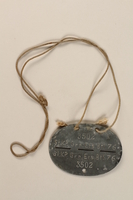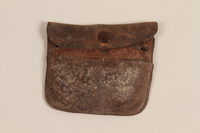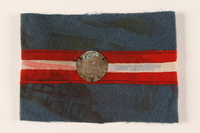Overview
- Description
- The Knud Dyby papers consist of correspondence, personal narratives, photocopied records, photographs, printed materials, resistance materials, and subject files documenting the German occupation of Denmark and Knud Dyby’s involvement in resistance work including rescuing Danish Jews and transmitting information.
Correspondence includes notes and translations documenting Knud Dyby’s resistance work during the war and include a letter from journalist Leif Hendil, a letter from Dwight D. Eisenhower about Brotherhood Week, and Dyby’s own letter advocating for the collection and display of visual evidence documenting the rescue of Jews during the Holocaust.
Personal narratives include Knud Dyby’s memoir, Short Stories from a Long Life, his expression of gratitude for the recognition he received as a rescuer, and a vignette about smuggling an American pilot out of Denmark. This series also includes a copy of Frank Meissner’s narrative about his Youth Aliyah work in Denmark from 1939 to 1943 and being smuggled to Sweden on a fishing boat in October 1943.
Photocopied records duplicate unknown source material including records documenting the German occupation of Denmark, Danish resistance, Knud Dyby, and antisemitism and Holocaust denial. Photocopied records documenting the German occupation of Denmark include correspondence, warnings, and regulations from the Danish Commerce Department, Justice Department, Police Commissioners, Nazi party, and the police in Malmö; reports about the Frikorps Danmark, Waffen SS, Sicherheitsdienst, and SS‐Sonder‐Kommando Danemark. Photocopied records documenting Danish resistance include calls for anti‐Nazi action, narratives about Jewish deportations and escapes, articles about Danish resistance and Jewish rescue, and lists of collaborators. Photocopies of letters and articles document Knud Dyby’s participation in Danish resistance and Jewish rescue. This series also includes photocopied articles and brochures propagating antisemitism and Holocaust denial, mostly by Heinz Roth.
Photographs include a portrait assumed to be of Knud Dyby, a picture of boats used by the Danish‐Swedish Refugee Service, and pictures documenting an exhibit about Danish‐Swedish underground cooperation.
Printed materials primarily consist of issues or partial issues of Danish wartime underground, opposition, and mainstream news publications. The series also includes wartime announcements, flyers, pamphlets, and an airdropped leaflet as well as later clippings and brochures about occupied Denmark.
Resistance materials include blank and false identification papers and information for the underground newspaper service and from Swedish partners to the Danish underground.
Subject files include a copy of a California resolution recognizing Knud Dyby, a copy of Hitler’s September 1, 1939 Reichstag speech and January 1, 1945 New Year’s speech, information about Wehrmacht uniforms given to Dyby, a ration card for tobacco, and a travel pass. - Date
-
inclusive:
1940-1992
- Credit Line
- United States Holocaust Memorial Museum Collection, Gift of Knud Dyby
- Collection Creator
- Knud D. Dyby
- Biography
-
Knud Dyring Olsen (later Knud Dyby, 1915-2011) was born in Vorup, Denmark, and raised in Randers. Knud’s father was a typographer and ran his own printing and advertising shop. Knud’s mother was a homemaker, and he had one younger brother. The Olsen family were part of a traditional community and valued strong morals, though they were not particularly religious. After finishing school, Knud became an apprentice at his father’s print shop. In his free time, Knud became a skilled sailor, piloting his small sailboat around local waters. When Knud turned 18, he reported to the Danish military to serve his compulsory year in the army or navy. During his initial review, he was selected as one of two men from his county to serve in the guard regiment for King Christian X. Knud served in the King’s guard for one year before returning to his position at the printshop.
In 1938, when Germany invaded the Sudetenland (a northern region of Czechoslovakia), Knud and many others were called back to military service to ensure the Danish military was at full strength. Eventually, he returned to the printing trade, though there was less and less work for him because access to paper dwindled as Germany continued to spread its influence in Europe. In September 1939, Germany and the Soviet Union started World War II (1939-1945) by invading Poland. Germany invaded Denmark on April 9, 1940, but allowed the Danish government to remain in control and signed a non-aggression treaty. This shift resulted in even less work for Knud, so when the Danish State offered former royal guardsmen positions in the Danish police force he joined eagerly. He briefly attended the police academy before being assigned to a station in Copenhagen.
Many Danish people, including Knud, did not enjoy living in an occupied country, and a robust resistance and sabotage network developed throughout the nation, especially in Copenhagen. Even while serving as a police officer, Knud would support resistance efforts as often as he could. Sometimes he would take a police report for a minor crime, like throwing a brick through a Nazi recruitment office, that he had helped carry out and never file the report. Other times, he would supply information or weapons to the resistance, or warn fellow Danes when an act of sabotage was expected so that they could avoid being injured. In mid-1943, Danish resistance efforts increased, and when German authorities pushed the Danish government to arrest and prosecute resistors, the government declined and resigned. At the end of August, German authorities declared martial law, and developed a plan to deport the roughly 8,000 Jews in Denmark to concentration camps in early October, at the end of Rosh Hashanah, the Jewish New Year.
On September 28, 1943, Georg Ferdinand Duckwitz, a German diplomat, secretly informed Danish politicians of the deportation plan, and they warned Chief Rabbi Marcus Melchior. On September 29, the start of the holiday, the Rabbi cancelled services and urged people to go into hiding or flee. By the time the Gestapo moved to round them up, there was almost no one left in the cities. Most Danish police refused to cooperate with German authorities, denying them entry to Jewish property, and not reporting any Jews found in hiding. Many ordinary Danish citizens protested the round-ups and supported efforts to hide and then smuggle the Jewish refugees across the Øresund Strait, to neutral Sweden, which had agreed to accept the refugees.
One of Knud’s friends knew that he helped the resistance, and asked him to help guide some Jewish neighbors to the harbor safely so that they could escape to Sweden. Knud agreed to help and hid them and others in their group in the fishermen’s supply shacks down by the water to wait for the boats once they reached the harbor. Knud continued to help guide Jewish refugees to the harbor over the next couple of weeks. Within a month, more than 7,000 Danish Jews had been transported to Sweden by many different resistance groups and individuals. Knud continued to organize boats to ferry anti-Nazi politicians, journalists, saboteurs, refugees, downed Allied pilots, and resistance members across the Strait. These boats also ferried weapons, military intelligence, and mail between the two nations. The Harbor Patrol was operated by the police, so Knud was able to use his connections to keep track of when and where German patrols would be located. While he was a skilled sailor, he only took a few boatloads of people across the Strait himself, fearing that if he were caught, he knew too much valuable information about the operation. At one point, a bookseller who lived near Knud reported him to his police captain for anti-German activities. To protect himself and his family, Knud petitioned and received permission to legally change his name to Kund D. Dyby.
Resistance and sabotage efforts across Denmark increased in 1944, and the German authorities viewed the non-responsive Danish police as a serious threat. In September, German soldiers and the Gestapo dissolved the Danish police force, raided police stations, and arrested approximately 2,000 officers. Kund had just returned home after working a night shift the previous evening when he heard sirens calling him back to the station. By the time he arrived, German officers were loading his fellow policemen into trucks. Knud quickly ducked into a nearby station storehouse to stay out of sight. Blank forms and documents, as well as official stamps to create identity papers were stored here, so Knud filled a sack with what he could grab and took the materials. Many of his fellow officers were deported to Neuengamme and Buchenwald concentration camps in Germany. Knud knew that he was not safe now that the police had been arrested, so he went underground and worked for the resistance as a member of several groups, including the Danish-Swedish Refugee Service. He changed apartments every three months, and continued his previous resistance activities. He created multiple sets of identity papers for himself and other members of the resistance using the materials he’d taken from the storehouse.
On May 4, 1945, German forces in Denmark surrendered. Knud, and many members of the resistance, were issued special armbands by the Danish Freedom Council, the unofficial government-in-exile, to formally convert them into a legitimate army for their protection. Under the Geneva Convention, resistance members could be considered guerillas and executed. After the war, Knud decided to keep the surname Dyby, and immigrated to the United States in 1946. He briefly ran an import business in New York City, but quickly returned to printing and worked as a typographer for Fortune magazine. Knud met Elin Rasmussen (1926-2005) while she was working for the Danish Foreign Ministry. The couple married in 1952, in Brooklyn, and had one child. Elin’s job led the family to settle just outside of San Francisco, California. He worked as a foreman in several different print shops before retiring. Knud often spoke to student groups about his varied experiences during the war.
Physical Details
- Genre/Form
- Photographs.
- Extent
-
2 boxes
6 oversize folders
- System of Arrangement
- The Knud Dyby papers are arranged as seven series: I. Correspondence, approximately 1944-1986, II. Personal narratives, 1984-1992, III. Photocopied records, approximately 1989, IV. Photographs, approximately 1945, V. Printed materials, 1943-1985, VI. Resistance materials, approximately 1940-1945, VII. Subject files, approximately 1944-1989
Rights & Restrictions
- Conditions on Access
- There are no known restrictions on access to this material.
- Conditions on Use
- Donor retains copyright on his personal narratives. The user is solely responsible for making a determination as to if and how other material in this collection may be used.
Keywords & Subjects
- Topical Term
- World War, 1939-1945--Denmark--Copenhagen. World War, 1939-1945--Underground movements--Denmark. World War, 1939-1945--Jews--Rescue--Denmark. Holocaust, Jewish (1939-1945)--Denmark. World War, 1939-1945--Underground literature--Denmark. Righteous Gentiles in the Holocaust--Denmark.
- Geographic Name
- Denmark--History--German occupation, 1940-1945.
Administrative Notes
- Holder of Originals
-
United States Holocaust Memorial Museum
- Legal Status
- Permanent Collection
- Provenance
- Knud Dyby donated the Knud Dyby papers to the United States Holocaust Memorial Museum in 1989 and 1992. The accessions formerly cataloged as 1992.A.0065 and 1999.A.0290 have been incorporated into this collection.
- Funding Note
- The cataloging of this collection has been supported by a grant from the Conference on Jewish Material Claims Against Germany.
- Primary Number
- 1989.297.341
- Record last modified:
- 2023-03-30 15:12:12
- This page:
- https://collections.ushmm.org/search/catalog/irn521521
Additional Resources
Download & Licensing
- See Rights and Restrictions
- Terms of Use
- This record is digitized but cannot be downloaded online.
In-Person Research
- Available for Research
- Plan a Research Visit
-
Request in Shapell Center Reading Room
Bowie, MD
Contact Us
Also in Knud Dyby collection
The collection consists of artifacts and documents relating to the experiences of Knud Dyby and his involvement with several Danish underground organizations during World War II.
Date: 1944-1945

Knife bayonet owned by a Danish resistance member
Object
The bayonet (a) has a grooved blade and attaches to a rifle by a deep groove in the handle. The sheath (b) has a leather upper that can be attached to a belt and a metal bottom that covers the bayonet blade. The leather and metal parts can be separated. The bayonet and bayonet sheath relate to Knud Dyby and his involvement with several Danish underground organizations during World War II

German military identification tag given to a Danish resistance member
Object
The German military dog tag was acquired by Knud Dyby while he was a member in several Danish underground resistance organizations during World War II. The dog tag originally belonged to one of five German Wehrmacht soldiers who surrendered their uniforms, weapons, and identification tags to Dyby in 1944 or early 1945. These men were originally international circus artists who wished to become refugees in Sweden rather than fight the Soviets during the winter along the Eastern Front. They and Dyby agreed that the uniforms could be useful to the resistance movement. The tag has a row of three, horizontal slits cut across the center line, allowing the tag to easily be snapped in half. This would create two identical tags used to identify a deceased or unconscious soldier; one half kept with the soldier and the second used for administrative purposes. Dyby worked with the Danish underground during the German occupation of Denmark. He used knowledge and skills gained from his prewar printing and advertising business, sailing expertise, and King’s Royal Guard service as well as his wartime position with the Danish police force to transmit intelligence data and arrange for boats to ferry refugees, including Jewish families, from Denmark to Sweden. He immigrated to the United States after the war.

Leather pouch for a dog tag given to a Danish resistance member
Object
Leather pouch used to hold a German military dog tag acquired by Knud Dyby while he was a member in several Danish underground resistance organizations during World War II. The dog tag and pouch originally belonged to one of five German Wehrmacht soldiers who surrendered their uniforms, weapons, and identification tags to Dyby in 1944 or early 1945. These men were originally international circus artists who wished to become refugees in Sweden rather than fight the Soviets during the winter along the Eastern Front. They and Dyby agreed that the uniforms could be useful to the resistance movement. Dyby worked with the Danish underground during the German occupation of Denmark. He used knowledge and skills gained from his prewar printing and advertising business, sailing expertise, and King’s Royal Guard service as well as his wartime position with the Danish police force to transmit intelligence data and arrange for boats to ferry refugees, including Jewish families, from Denmark to Sweden. He immigrated to the United States after the war.

Armband with a royal coat of arms issued to a Danish resistance member
Object
Blue, red, and white armband with a medallion issued to Knud Dyby, a member of the Danish underground resistance, on May 4 or 5, 1945. The armbands, which appeared abruptly throughout Denmark, were issued by the Danish Freedom Council, Denmark's unofficial government-in-exile in England from July 1944 to May 1945. The armbands were meant to identify resistance members as legitimate combatants, rather than guerilla forces, to ensure they were protected under Geneva Convention rules defining combatants and how they should be treated by military forces. Denmark was occupied by Germany on April 9, 1940. The Danes were allowed to retain control of civil affairs, until the Germans declared martial law on August 29, 1943. The Danish Freedom Council was formed that September to coordinate the resistance movement. Dyby worked with the Danish underground during the German occupation of Denmark. He used knowledge and skills gained from his prewar printing and advertising business, sailing expertise, and King’s Royal Guard service as well as his wartime position with the Danish police force to transmit intelligence data and arrange for boats to ferry refugees, including Jewish families, from Denmark to Sweden. German forces in Denmark surrendered on May 5, 1945. Dyby immigrated to the United States after the war.
Underground Danish periodical circulating news from the United Kingdom
Object
An underground newspaper, Nyheder fra Storbritanien, acquired by Knud Dyby while he was a member in several Danish underground resistance organizations during World War II. This was one of many underground publications that grew out of increased demand for information as German authorities increased censorship in the final years of the war. In April 1940, Germany invaded and occupied Denmark, which prompted a growing demand for information about the war and the need for newspapers. Many underground publications were created as part of a robust resistance and sabotage movement in the nation. Dyby worked with the Danish underground during the occupation of Denmark. He used knowledge and skills gained from his prewar printing and advertising business, sailing expertise, and King’s Royal Guard service as well as his wartime position with the Danish police force to transmit intelligence data and arrange for boats to ferry refugees, including Jewish families, from Denmark to Sweden. He immigrated to the United States after the war.
Danish periodical circulating illustrated news about the liberation
Object
An illustrated newspaper, Billed-Bladet, acquired by Knud Dyby while he was a member in several Danish underground resistance organizations during World War II. This was one of many publications that increased circulation due to increased demand for information as German authorities increased censorship in the final years of the war. In April 1940, Germany invaded and occupied Denmark, which prompted a growing demand for information about the war and the need for more newspapers. Many publications went underground for a time as part of a robust resistance and sabotage movement in the nation. Dyby worked with the Danish underground during the occupation of Denmark. He used knowledge and skills gained from his prewar printing and advertising business, sailing expertise, and King’s Royal Guard service as well as his wartime position with the Danish police force to transmit intelligence data and arrange for boats to ferry refugees, including Jewish families, from Denmark to Sweden. He immigrated to the United States after the war.
Danish periodical circulating illustrated news about the post-liberation period
Object
An illustrated newspaper, Billed-Bladet, acquired by Knud Dyby while he was a member in several Danish underground resistance organizations during World War II. This was one of many publications that increased circulation due to increased demand for information as German authorities increased censorship in the final years of the war. In April 1940, Germany invaded and occupied Denmark, which prompted a growing demand for information about the war and the need for more newspapers. Many publications went underground for a time as part of a robust resistance and sabotage movement in the nation. Dyby worked with the Danish underground during the occupation of Denmark. He used knowledge and skills gained from his prewar printing and advertising business, sailing expertise, and King’s Royal Guard service as well as his wartime position with the Danish police force to transmit intelligence data and arrange for boats to ferry refugees, including Jewish families, from Denmark to Sweden. He immigrated to the United States after the war.



